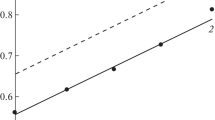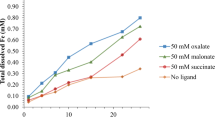Summary
In anaerobic corrosion experiments, hydrogenase-positiveDesulfovibrio strains, grown with limiting lactate concentrations in the presence of steel wool, formed more sulphide than expected or observed with lactate alone. The additional sulphide obviously originated from sulphate reduction with cathodically formed hydrogen from the steel surface. The hydrogenasenegativeD. sapovorans did not produce additional sulphide. The observations agree with the theory of von Wolzogen Kühr and van der Vlugt (1934) that explains anaerobic corrosion as a cathodic depolarization of iron surfaces by hydrogen-consuming sulphate-reducing bacteria. The influence of the iron surface area, the salt concentration and the pH-value on the utilization of cathodically formed hydrogen was investigated. The significance of an additional organic electron donor for the corrosion of iron in aqueous environments is discussed.
Similar content being viewed by others
References
Bell RG, Chor Kiang Lim (1981) Corrosion of mild and stainless steel by four tropicalDesulfovibrio desulfuricans strains. Can J Microbiol 27:242–245
Booth GH, Wormwell F (1961) Corrosion of mild steel by sulfate-reducing bacteria. Effect of different strains of organisms. Proceedings of the 1st International Congress of Metallic Corrosion, London, pp 341–353
Booth GH, Cooper PM, Wakerley DS (1966) Corrosion of mild steel by actively growing cultures of SRB, the influence of ferrous iron. Br Corros J 1:345–349
Booth GH, Cooper AW, Cooper PM (1967) Rates of Microbial Corrosion in Continuous Culture. Chem Ind 9:2084–2085
Booth GH, Elford L, Wakerley DS (1968) Corrosion of mild steel by sulfate reducing bacteria: an alternative mechanism. Br Corros J 3:242–245
Cord-Ruwisch R (1985) A quick method for the determination of dissolved and precipitated sulfides in cultures of sulfatereducing bacteria. J Microbiol Methods 4:33–36
Cord-Ruwisch R, Widdel F, Kleinitz W (1985) Sulfate-reducing bacteria and their economic activities. International Symposium on Oilfield and Geothermal Chemistry held in Phoenix Arizona, Society of Petroleum Engineers of AIME (SPE) 13554:53–64
Hardy JA (1983) Utilization of cathodic hydrogen by sulfate reducing bacteria. Br Corros J 18:190–193
Iverson WP, Olson GJ (1984) Anaerobic corrosion of iron and steel: a novel mechanism. In: Klug MJ, Reddy CA (eds) Current perspectives in microbial ecology. American Society for Microbiology, Washington, pp 623–627
King RA, Miller JDA (1971) Corrosion by sulfate reducing bacteria. Nature 233:491–492
King RA, Miller JDA, Wakerley DS (1973) Corrosion of mild steel in cultures of sulfate-reducing bacteria, effect of changing the soluble iron concentration during growth. Br Corros J 8:pp 89–93
Laanbroek HJ, Abee T, Voogd IL (1982) Alcohol conversation byDesulfobulbus propionicus Lindhorst in the presence and absence of sulfate and hydrogen. Arch Microbiol 133:178–184
Pfennig N, Widdel F, Trüper HG (1981) The dissimilatory sulfate reducing bacteira. In: Starr MP, Stolp H, Trüper HG, Balows A, Schlegel HG (eds) The procaryotes. Vol I, Springer Verlag, Berlin, pp 926–940
Postgate JR (1984) The sulfate-reducing bacteria, 2nd ed, Cambridge University Press, London
Von Wolzogen Kühr CAH, van der Vlugt IS (1934) The graphitization of cast iron as an electrobiochemical process in anaerobic soils. Water 18:147–165
Widdel F, Pfennig N (1984) Dissimilatory sulfate- or sulfurreducing bacteria. In: Krieg NR, Holt JG (eds) Bergey's manual of systematic bacteriology, Baltimore/London: Williams & Wilkins, pp 663–679
Author information
Authors and Affiliations
Rights and permissions
About this article
Cite this article
Cord-Ruwisch, R., Widdel, F. Corroding iron as a hydrogen source for sulphate reduction in growing cultures of sulphate-reducing bacteria. Appl Microbiol Biotechnol 25, 169–174 (1986). https://doi.org/10.1007/BF00938942
Received:
Revised:
Issue Date:
DOI: https://doi.org/10.1007/BF00938942




